Type 5 secretion system
Home » » Type 5 secretion systemYour Type 5 secretion system images are available. Type 5 secretion system are a topic that is being searched for and liked by netizens now. You can Get the Type 5 secretion system files here. Download all royalty-free photos and vectors.
If you’re looking for type 5 secretion system images information related to the type 5 secretion system topic, you have come to the ideal site. Our site always provides you with hints for seeing the highest quality video and image content, please kindly surf and find more informative video articles and images that match your interests.
Type 5 Secretion System. The type II secretion system T2SS is a cell envelope-spanning macromolecular complex that is prevalent in Gram-negative bacterial species. Initially the T6SS was associated with bacterial virulence concerning eukaryotic host cells but a scarce number. This membrane-associated complex seems to be embedded exclusively in. It was recently demonstrated that the related fish pathogen Flavobacterium columnare requires a functional type IX protein secretion system T9SS to cause disease.

T6SS gene clusters are widely distributed in proteobacteria and may exist in several chromosomal copies Bingle et al 2008. The type III secretion systems are assembled from core components of the flagellar machine 1. The T3SS forms a syringe-like structure spanning both bacterial membranes and the host cell plasma membrane that translocates toxic effector proteins into the cytoplasm of the host cell. The secretion system is currently divided into five subclasses types 5a to 5e based on differences in gene organization and protein structure. The Type 5 secretion system The T5SS is the simplest and most widespread protein secretion mechanism in Gram-negative bacteria. Type V secretion system T5SS substrates are unique in that unlike other secreted substrates which cross the bacterial membrane with the help of a dedicated secretion apparatus or membrane channel they secrete themselves.
Single-particle analysis of electron microscopy structures elucidates the mycobacterial ESX-5 type VII secretion system membrane complex.
Journet and Cascales 2016. Here we report the molecular architecture of the ESX-5 membrane complex from Mycobacterium xenopi determined at 13 Å resolution by electron microscopy. The type II secretion system T2SS is a cell envelope-spanning macromolecular complex that is prevalent in Gram-negative bacterial species. Type V secretion Type V secretion systems T5SSs can be grouped into three main categories. Type V secretion denotes a variety of secretion systems that cross the outer membrane in Gram-negative bacteria but that depend on the Sec machinery for transport through the inner membrane. Initially the T6SS was associated with bacterial virulence concerning eukaryotic host cells but a scarce number.
 Source: sciencedirect.com
Source: sciencedirect.com
The system is composed of a core set of highly conserved proteins that assemble an. Select Secretion System Type 1 Secretion System Type 2 Secretion System Type 3 Secretion System Type 5 Secretion System Type 6 Secretion System Undetermined Type This research was conducted in conjunction with the Telemedicine and Advanced Technology Research Center TATRC and US Army Medical Research and Development Command USAMRDC. Many bacterial species deploy Type IV Secretion Systems T4SSs to deliver DNA protein or other macromolecules to bacterial or eukaryotic cell targets Li et al 2019. The system is composed of a core set of highly conserved proteins that assemble an. Initially the T6SS was associated with bacterial virulence concerning eukaryotic host cells but a scarce number.

The T3SS forms a syringe-like structure spanning both bacterial membranes and the host cell plasma membrane that translocates toxic effector proteins into the cytoplasm of the host cell. Single-particle analysis of electron microscopy structures elucidates the mycobacterial ESX-5 type VII secretion system membrane complex. Journet and Cascales 2016. T6SS gene clusters are widely distributed in proteobacteria and may exist in several chromosomal copies Bingle et al 2008. Many bacterial species deploy Type IV Secretion Systems T4SSs to deliver DNA protein or other macromolecules to bacterial or eukaryotic cell targets Li et al 2019.
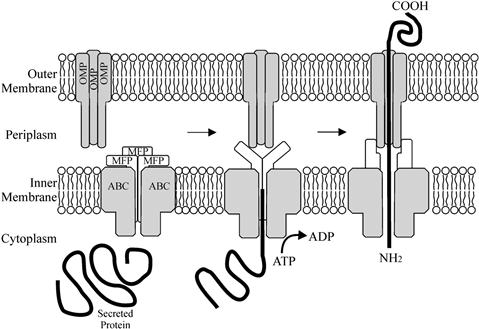 Source: basicmedicalkey.com
Source: basicmedicalkey.com
The four core proteins of the ESX-5 complex EccB 5 EccC 5 EccD 5 and EccE 5 assemble with equimolar stoichiometry into an oligomeric assembly that displays six-fold symmetry. It serves as the predominant virulence mechanism of many bacteria including those of the emerging human pathogens Vibrio vulnificus and Aeromonas hydrophila. This membrane-associated complex seems to be embedded exclusively in. A chimeric EccBMycP fusion protein is functional and a stable component of the ESX-5 type VII secretion system membrane complex. T9SSs secrete cell surface adhesins gliding motility proteins peptidases and.
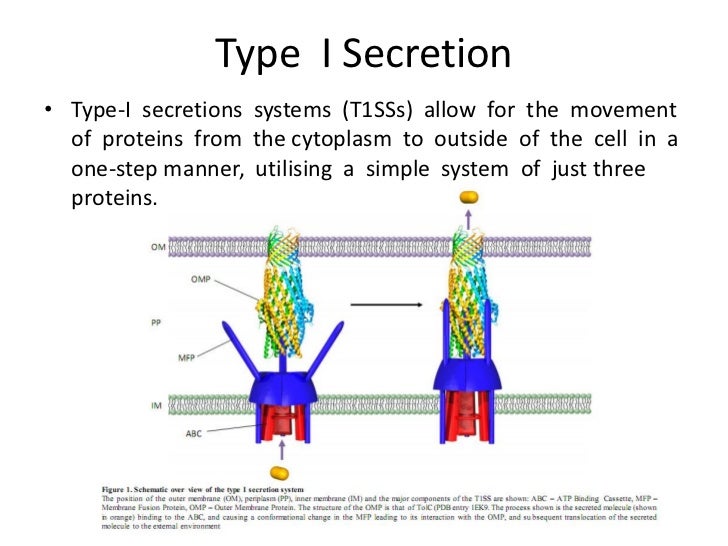 Source: slideshare.net
Source: slideshare.net
The type IV systems the subject of this review are built from core components of conjugation machines. Type V secretion system T5SS substrates are unique in that unlike other secreted substrates which cross the bacterial membrane with the help of a dedicated secretion apparatus or membrane channel they secrete themselves. This is a promiscuous secretion family both in terms of the translocated substrates large nucleoprotein conjugation intermediates an AB toxin. The exception to this is the type V secretion systems autotransporters and two-partner secretion systems which use a. Journet and Cascales 2016.
 Source: onlinelibrary.wiley.com
Source: onlinelibrary.wiley.com
Select Secretion System Type 1 Secretion System Type 2 Secretion System Type 3 Secretion System Type 5 Secretion System Type 6 Secretion System Undetermined Type This research was conducted in conjunction with the Telemedicine and Advanced Technology Research Center TATRC and US Army Medical Research and Development Command USAMRDC. The type IV systems the subject of this review are built from core components of conjugation machines. A chimeric EccBMycP fusion protein is functional and a stable component of the ESX-5 type VII secretion system membrane complex. The four core proteins of the ESX-5 complex EccB 5 EccC 5 EccD 5 and EccE 5 assemble with equimolar stoichiometry into an oligomeric assembly that displays six-fold symmetry. However the majority of these are large complexes spanning the entire cell envelope and are thought to use ATP energy directly Durand et al 2009.
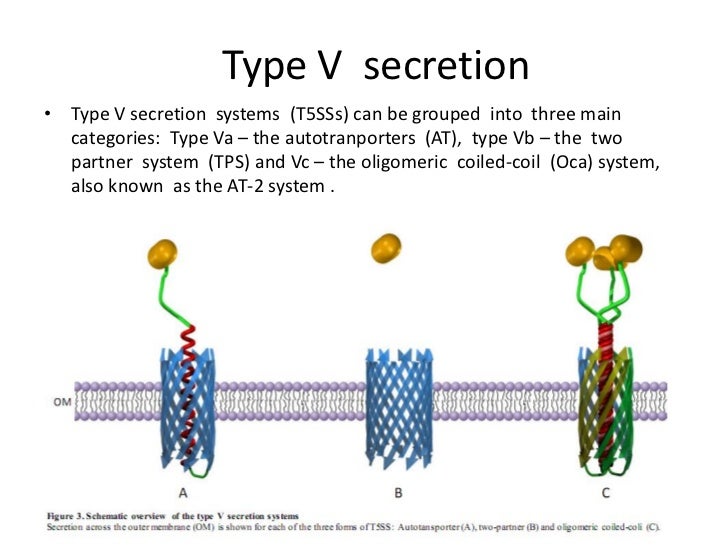 Source: slideshare.net
Source: slideshare.net
The system is composed of a core set of highly conserved proteins that assemble an. Select Secretion System Type 1 Secretion System Type 2 Secretion System Type 3 Secretion System Type 5 Secretion System Type 6 Secretion System Undetermined Type This research was conducted in conjunction with the Telemedicine and Advanced Technology Research Center TATRC and US Army Medical Research and Development Command USAMRDC. Type Va the autotranporters AT type Vb the two partner system TPS and Vc the oligomeric coiled-coil Oca system also known as the AT-2 system. Type V secretion system T5SS substrates are unique in that unlike other secreted substrates which cross the bacterial membrane with the help of a dedicated secretion apparatus or membrane channel they secrete themselves. The type II secretion system T2SS is a cell envelope-spanning macromolecular complex that is prevalent in Gram-negative bacterial species.
 Source: pnas.org
Source: pnas.org
The four core proteins of the ESX-5 complex EccB 5 EccC 5 EccD 5 and EccE 5 assemble with equimolar stoichiometry into an oligomeric assembly that displays six-fold symmetry. This is a promiscuous secretion family both in terms of the translocated substrates large nucleoprotein conjugation intermediates an AB toxin. Type V secretion system T5SS substrates are unique in that unlike other secreted substrates which cross the bacterial membrane with the help of a dedicated secretion apparatus or membrane channel they secrete themselves. T9SSs secrete cell surface adhesins gliding motility proteins peptidases and. A chimeric EccBMycP fusion protein is functional and a stable component of the ESX-5 type VII secretion system membrane complex.
 Source: slideplayer.com
Source: slideplayer.com
This membrane-associated complex seems to be embedded exclusively in. The secretion system is currently divided into five subclasses types 5a to 5e based on differences in gene organization and protein structure. However the majority of these are large complexes spanning the entire cell envelope and are thought to use ATP energy directly Durand et al 2009. T9SSs secrete cell surface adhesins gliding motility proteins peptidases and. The four core proteins of the ESX-5 complex EccB 5 EccC 5 EccD 5 and EccE 5 assemble with equimolar stoichiometry into an oligomeric assembly that displays six-fold symmetry.
 Source: wikiwand.com
Source: wikiwand.com
The type IV systems the subject of this review are built from core components of conjugation machines. Many bacterial species deploy Type IV Secretion Systems T4SSs to deliver DNA protein or other macromolecules to bacterial or eukaryotic cell targets Li et al 2019. Type Va the autotranporters AT type Vb the two partner system TPS and Vc the oligomeric coiled-coil Oca system also known as the AT-2 system. This membrane-associated complex seems to be embedded exclusively in. The four core proteins of the ESX-5 complex EccB 5 EccC 5 EccD 5 and EccE 5 assemble with equimolar stoichiometry into an oligomeric assembly that displays six-fold symmetry.

The Type 5 secretion system The T5SS is the simplest and most widespread protein secretion mechanism in Gram-negative bacteria. The exception to this is the type V secretion systems autotransporters and two-partner secretion systems which use a. The Type 5 secretion system The T5SS is the simplest and most widespread protein secretion mechanism in Gram-negative bacteria. A chimeric EccBMycP fusion protein is functional and a stable component of the ESX-5 type VII secretion system membrane complex. Type V secretion system T5SS substrates are unique in that unlike other secreted substrates which cross the bacterial membrane with the help of a dedicated secretion apparatus or membrane channel they secrete themselves.
 Source: analyticalsciencejournals.onlinelibrary.wiley.com
Source: analyticalsciencejournals.onlinelibrary.wiley.com
Waksman 2019The T4SSs are composed mainly of two subfamilies the conjugation systems and effector translocators Cascales and Christie 2003Conjugation systems are of considerable medical. A chimeric EccBMycP fusion protein is functional and a stable component of the ESX-5 type VII secretion system membrane complex. It was recently demonstrated that the related fish pathogen Flavobacterium columnare requires a functional type IX protein secretion system T9SS to cause disease. However the majority of these are large complexes spanning the entire cell envelope and are thought to use ATP energy directly Durand et al 2009. Type V secretion system T5SS substrates are unique in that unlike other secreted substrates which cross the bacterial membrane with the help of a dedicated secretion apparatus or membrane channel they secrete themselves.
 Source: sciencedirect.com
Source: sciencedirect.com
The T3SS forms a syringe-like structure spanning both bacterial membranes and the host cell plasma membrane that translocates toxic effector proteins into the cytoplasm of the host cell. The T6SS type VI secretion system is one of a recent specialized secretion system identified in Gram-negative bacteria. Bacterial secretion systems also require energy transduction systems to power export of their substrates through the outer membrane. This is a promiscuous secretion family both in terms of the translocated substrates large nucleoprotein conjugation intermediates an AB toxin. Many bacterial species deploy Type IV Secretion Systems T4SSs to deliver DNA protein or other macromolecules to bacterial or eukaryotic cell targets Li et al 2019.
 Source: wikiwand.com
Source: wikiwand.com
The T6SS type VI secretion system is one of a recent specialized secretion system identified in Gram-negative bacteria. However the majority of these are large complexes spanning the entire cell envelope and are thought to use ATP energy directly Durand et al 2009. It was recently demonstrated that the related fish pathogen Flavobacterium columnare requires a functional type IX protein secretion system T9SS to cause disease. T9SSs secrete cell surface adhesins gliding motility proteins peptidases and. The secretion system is currently divided into five subclasses types 5a to 5e based on differences in gene organization and protein structure.
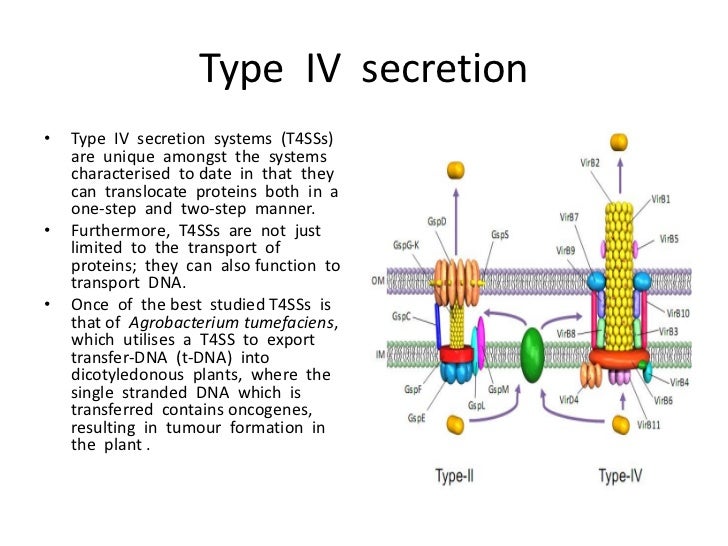 Source: slideshare.net
Source: slideshare.net
They are possibly the simplest bacterial secretion systems because they consist only of a single polypeptide chain or two chains in the case of two-partner secretion. The four core proteins of the ESX-5 complex EccB 5 EccC 5 EccD 5 and EccE 5 assemble with equimolar stoichiometry into an oligomeric assembly that displays six-fold symmetry. The type III secretion systems are assembled from core components of the flagellar machine 1. Initially the T6SS was associated with bacterial virulence concerning eukaryotic host cells but a scarce number. The T6SS type VI secretion system is one of a recent specialized secretion system identified in Gram-negative bacteria.
 Source: cell.com
Source: cell.com
The T6SS type VI secretion system is one of a recent specialized secretion system identified in Gram-negative bacteria. This membrane-associated complex seems to be embedded exclusively in. They are possibly the simplest bacterial secretion systems because they consist only of a single polypeptide chain or two chains in the case of two-partner secretion. Bacterial secretion systems also require energy transduction systems to power export of their substrates through the outer membrane. The type IV systems the subject of this review are built from core components of conjugation machines.
 Source: researchgate.net
Source: researchgate.net
Type V secretion denotes a variety of secretion systems that cross the outer membrane in Gram-negative bacteria but that depend on the Sec machinery for transport through the inner membrane. Type V secretion denotes a variety of secretion systems that cross the outer membrane in Gram-negative bacteria but that depend on the Sec machinery for transport through the inner membrane. T6SS gene clusters are widely distributed in proteobacteria and may exist in several chromosomal copies Bingle et al 2008. Bacterial secretion systems also require energy transduction systems to power export of their substrates through the outer membrane. This membrane-associated complex seems to be embedded exclusively in.
 Source: researchgate.net
Source: researchgate.net
The type III secretion systems are assembled from core components of the flagellar machine 1. The type III secretion systems are assembled from core components of the flagellar machine 1. The type IV systems the subject of this review are built from core components of conjugation machines. The pathogenesis of these organisms involves two different secretion systems a type 3 secretion system T3SS and type 5 secretion systems T5SSs. The system is composed of a core set of highly conserved proteins that assemble an.
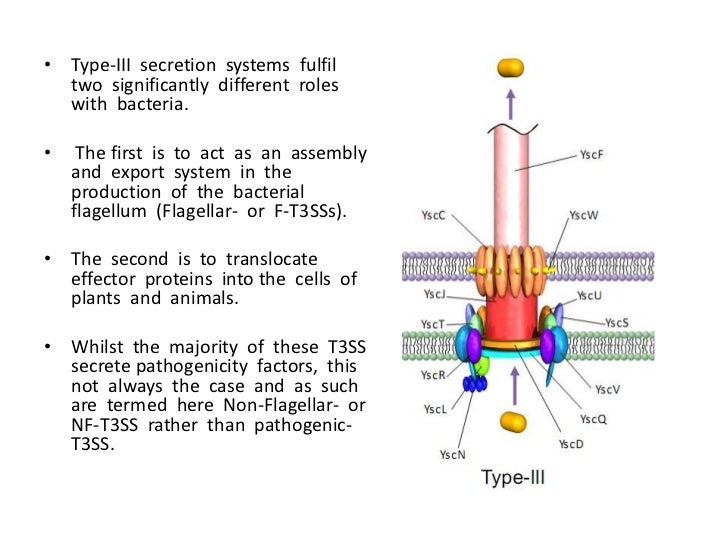 Source: slideshare.net
Source: slideshare.net
The type IV systems the subject of this review are built from core components of conjugation machines. Bacterial secretion systems also require energy transduction systems to power export of their substrates through the outer membrane. The T6SS type VI secretion system is one of a recent specialized secretion system identified in Gram-negative bacteria. The exception to this is the type V secretion systems autotransporters and two-partner secretion systems which use a. Single-particle analysis of electron microscopy structures elucidates the mycobacterial ESX-5 type VII secretion system membrane complex.
This site is an open community for users to do submittion their favorite wallpapers on the internet, all images or pictures in this website are for personal wallpaper use only, it is stricly prohibited to use this wallpaper for commercial purposes, if you are the author and find this image is shared without your permission, please kindly raise a DMCA report to Us.
If you find this site value, please support us by sharing this posts to your favorite social media accounts like Facebook, Instagram and so on or you can also bookmark this blog page with the title type 5 secretion system by using Ctrl + D for devices a laptop with a Windows operating system or Command + D for laptops with an Apple operating system. If you use a smartphone, you can also use the drawer menu of the browser you are using. Whether it’s a Windows, Mac, iOS or Android operating system, you will still be able to bookmark this website.